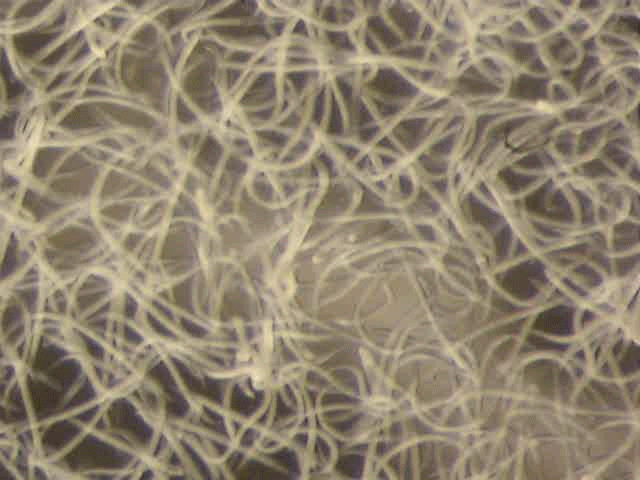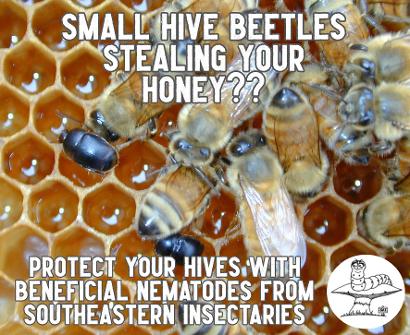
Southeastern Insectaries (S.E.I.) specializes in species of nematodes used to control Small Hive Beetles, although species produced by S.E.I. are used to control a wide range of other soil dwelling insect pests. Safe to handle, and are harmless to humans, pets, wildlife, and plants.
They pose no threat to the environment and are exempt from registration and regulation by EPA and FDA.
Beneficial nematodes are an environmentally friendly alternative. Biological pest control can be used to reduce the use of toxic chemical pesticides.
Target Pests
|
Crop Application |
Nematode Species |
|
Vegetables |
Sc, Hb |
|
Grass |
Sc, Hb |
|
Ornamentals |
Sc, Hb |
|
Nut Trees |
Sc |
|
Mushrooms |
Hb |
|
Fruit Vines |
Sc, Hb |
|
Fruit Trees |
Sc, Hb |
|
Citrus |
Hb |
|
H.I. (Heterorhabditis indica) |
S.C. (Steinernema carpocapsae)
|
H.B. (Heterorhabditis bacteriophora) |
S.R. (Steinernema riobrave) |
|
Small Hive Beetle, Japanese Beetles, White Grubs, Root Weevils, Armyworms, Cutworms, Clear Winged Moths, Fungus Gnats, and a variety of Beetle Grubs
|
Fleas, Mole Crickets, Armyworms, Cutworms, Artichoke Plum Moth, German Cockroaches Cranberry Girdler, Wood Borers, Root Weevils, Webworms, Billbugs, Bagworms, certain fruit flies, and Pecan Weevils
|
Japanese Beetles, May Beetles, June Beetles, Carrot Weevils, Strawberry Foot Weevils, Sweet Potato Weevils, Cucumber Beetles, Flea Beetles, and many other root feeding White Grubs
|
Small Hive Beetle, Diaprepes Root Weevil, Plum Cruculio, Mole Crickets and Blue Green Weevils |
S.E.I. produces a Superior Nematode
Always produced "in vivo" - by live insect host,
never substitute organic material.
Several species of nematodes are available. It is important that the proper species is used against a specific pest. Call S.E.I. for proper match-up.
*H.I. & S.R. orders through PayPal Below*

Heterorhabditis Indica Beneficial Nematodes
Target pests: Small Hive Beetles, White Grubs, Japanese Beetles, Root Weevils, Armyworms, Cutworms, Clear Winged Moths, Fungus Gnats
Application rates
*5 million H.i. & S.r. will treat 10 bee hives*
Area (sq. ft.) # of nematodes required
1......................................................................23,000
100..............................................................2,300,000
500.............................................................11,500,000
1,000..........................................................23,000,000
43,560 (1 Acre)....................................1,000,000,000
Call for orders larger than 50 million and receive
up to a 15% Discount
BENEFICIAL NEMATODES (H.i. &
S.r.) FOR
⬇SALE BUY NOW ⬇


- In 2005, the original research on the use of beneficial nematodes against Small Hive Beetles was conducted by Southeastern Insectaries, Inc. and the University of Georgia.
- Tests by Southeastern Insectaries, Inc. determined that Heterorhabditis Indica (H.i.) is highly effective in controlling Small Hive Beetle populations.
- Heterorhabditis indica quickly kills Small Hive Beetle larvae, pupae, and adults in the soil around hives.
- Each Small Hive Beetle larvae killed by H. Indica can cause reproduction of up to 20,000 more nematodes in the soil.
- Studies of SHB larvae leaving hives indicated that about 82% are within 24” of the hive and nearly 100% are within 36”.
- About 75% of these beetles were found in soil no more than 4” deep and 95% were no more than 6” deep.
- Such behavior makes them ideal candidates for control with nematodes.
- Controlled field studies in 2005 indicated that the mortality rate of Small Hive Beetles was 88 – 94% after one application of nematodes.
- Reproduction on killed hosts is paramount to good biological control.
- Some nematode species will not reproduce on Small Hive Beetles and should not be used.
- Southeastern Insectaries recommends that nematodes be used as soon as possible and within a one-week period.
- A single package of H.I. contains a minimum of 5 million nematodes and is enough to treat around 10 hives
- When a package of 5 million nematodes is mixed with a quantity of water (we recommend 10 gallons) the mix is then equally divided among 10 hives.
- Each package is a 7” x 8” re-sealable slider zip plastic bag containing a special gel which acts as a wet substrate for the nematodes.
- Nematodes do not enter the gel crystals.
- Nematodes should be rinsed with water from the gel by passing them through a tea strainer.
- Nematodes applied to damp soil surfaces around a hive will quickly enter the soil and attack the SHB. The best equipment for application of 1 gallon quantities around each hive is a common sprinkler type watering can.
- Studies have shown that about 82% of Small Hive Beetle larvae leaving hives are within 24” of the hive and nearly 100% are within 36”.
- Apply beneficial nematodes around and under the hive. This application area should extend to approximately 36".
- For best results, apply in the early morning or the late evening. It is also important to irrigate the area before and after beneficial nematode application.
- Nematodes suspended in watering cans or holding containers should be stirred or agitated frequently to prevent their setting and uneven distribution.
- Nematodes should be applied in early morning, late afternoon, or during overcast conditions.
- The soil around hives or garden plants should be wetted before and after nematode applications.
- Nematodes in packages or other containers should never be left in the sun because ultra-violet light will quickly kill the contents.
- Most beekeepers know that Small Hive Beetles originated in Africa and were first found in the USA in St. Lucie County, FL in 1998.
- In 1999, Small Hive Beetle were found in Georgia and South Carolina and has been expanding into surrounding areas ever since.
- Few hives in Georgia are not infested today.
- SHB survive in greater numbers around beehives located in forested areas than in open fields.
- They are more successful in sandy soils than in heavier soils.
- For survival, it is important that they enter the soil quickly after leaving the hive.
- Quick entry into the soil reduces the chances of their being preyed upon by ants, birds, and other predators.
- Thus, their quickness into soils results in their close proximity to the hive.
- Studies of SHB larvae leaving hives indicated that about 82% are within 24” of the hive and nearly 100% are within 36”.
- About 75% of these beetles were found in soil no more than 4” deep and 95% were no more than 6” deep.
- Such behavior makes them ideal candidates for control with nematodes.
- Female hive beetles may lay up to 1,000 eggs.
- Eggs are laid in cracks and crevices inside the hive.
- Eggs hatch in about 3 days (range 3 – 6 days).
- Larvae feed on pollen, honey, and brood inside of hive for 13.3 days.
- Larvae leave the hive and enter soil around the hive from 7:00 to 10:00 PM (peak at 9:00 PM).
- SHB remain as larvae in soil for 3 – 5 days.
- Mature larvae are about 1/4 to 3/8 inch in length.
- About 83% of larvae enter soil within 12 inches of the hive.
- About 80% burrow into soil to a depth of 1 – 4 inches.
- Hive Beetle larvae pupate after being larvae for 16 – 19 days.
- Pupal stage lasts about 8 days.
- New adult Hive Beetles emerge from the soil several days after becoming adults.
- New Hive Beetle adults cease development by November 1st in Georgia.
- Dry soils are more favorable for adult development.
- Life cycle of Small Hive Beetle averages 27 – 30 days.
- Adult Small Hive Beetles are known to live 188 days.
- Adults Hive Beetles hide during winter inside honey bee colonies and probably in honey houses.
Shipping Information
- $11.00 Flat Rate Shipping.
- All orders will be shipped ASAP; Times may vary due to inventory levels.
- Several species of nematodes are available. It is important that the proper species is used against a specific pest. Call S.E.I. for proper match-up.
- Live delivery of nematodes is guaranteed by SEI, when maximum temperatures aren't expected to exceed 79°.
- All orders will ship USPS or Fedex, unless there is a special shipping request.
- Can not ship to Hawaii, Guam, Puerto Rico, or U.S. V.I.
- All orders will be shipped 2nd Day Fedex or USPS ~ Unless indicated by customers for overnight services ~ Orders will be shipped Monday thru Wednesday.
- Call SEI for additional cost of using Fedex or USPS overnight services.
- When deemed necessary by SEI a insulated box and cold pack will be included at no additional cost.
- Customers receiving dead or / missing orders must notify SEI within 2 days following receipt of package or expected delivery date for guarantee to be honored.
- All orders will receive a email when order is shipped and expected date of delivery.
- All prices are subject to change without notice.
southeasterninsectaries@gmail.com
478-988-9412 or TOLL FREE 877-WORMSSS
Fax 478-988-9413
367 Moss Oaks Rd.
Perry, GA 31069
